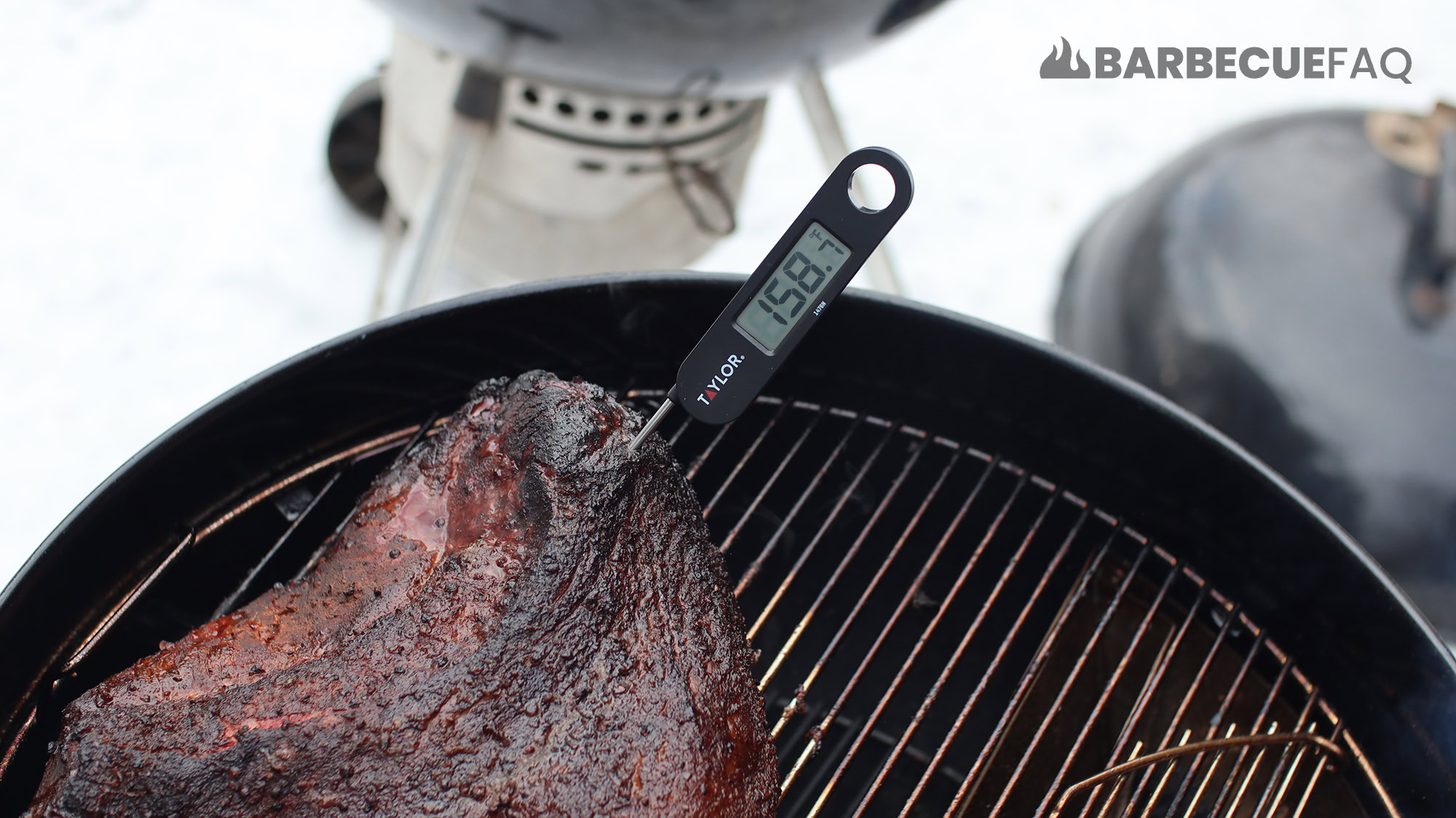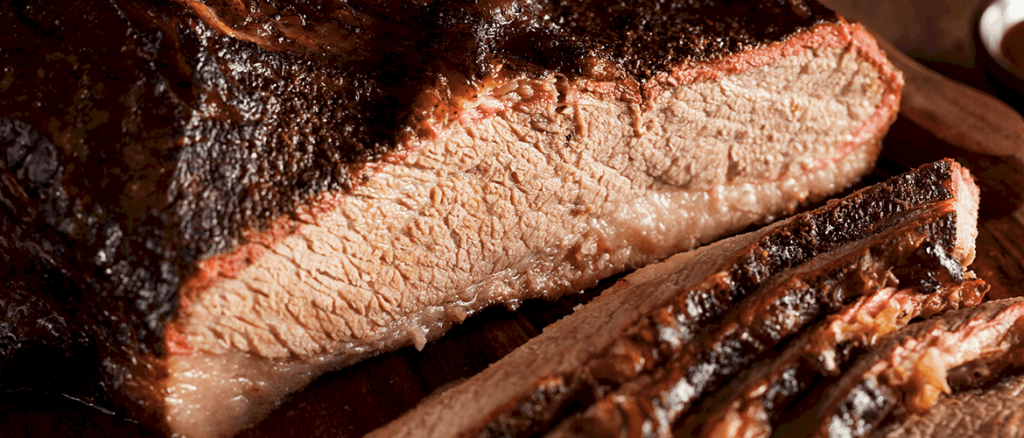My opinion on when to wrap:
- After at least 5-6 hours of smoking.
- Thickest part of the flat is 170-180F.
- Bark is dark, like a meteorite.
- The fat is squishy, pillow-y, and tear-able.
All of these things result in more flavorful brisket, every time.
Internal Temperature is a Fool’s Guide for When to Wrap Brisket
This is mainly because the common recommendations suck.
My quick recommendation is to go to at least 170F+, ideally 175-180F.
For some reason, a lot of articles, recipes, and videos will tell you to immediately wrap the brisket as soon as it reaches 150 or 160F (when it stalls).
In my humble opinion, wrapping at this stage is bad advice.
To start, none of these people will tell you where they’re probing the meat – for a complete Noob, they might probe the point and wrap based on this advice.
Showing why this is bad
The pictures below were taken at the same time.
Brisket flat temperature probing 147.2F:

Brisket point temperature probing at 158.7F:

In the first picture, if you wrapped at 158.7F based on the point, the flat and elsewhere are still pushing out tons of moisture.
There’s even a pooling of moisture on the flat still.
This is why I always say to probe the thickest part of the flat (below).

This is a middle ground between the front of the flat, which will finish the slowest and the point which will finish fast.
It tells us we’re out of the stall, our pellicle is set and we can wrap to speed the cook time.
The Reason You Don’t Wrap During the Stall is Because of Moisture
Brisket stalls because it’s sweating out moisture – which cools it down – that’s why it’s “stalling” in the first place.
Humans do the same thing – we sweat to cool down.

The sole reason you wrap is because it traps humidity and prevents the meat from sweating and speeds the cook time.
Again, same for humans – when the humidity is high we can’t sweat and we feel hotter.
BUT by wrapping during the stall you get:
- Bark that’s soft and mushy because of moisture.
- Less flavor from smoke (smoke is attracted to wet surfaces, aka when it’s sweating).
- Less fat render.
- Bark that looks brown, not black – meaning a proper pellicle hasn’t been formed.
Wrapping Brisket Based on Color
As the brisket continues to smoke, the rub will start setting up and the crust/bark will take on a red/brown/mahogany color.
Below are examples of 2 different brisket cooks.
Here’s a picture of the first one being put on my smoker at 11:34 am.

Here’s the meat at 1:41 pm.

Here’s the meat at 4:27 pm:

The overall smoke time above is 5 hours and slowly but surely the moisture on the surface is disappearing.
Here’s another example with a totally different brisket:

Here’s 6 hours later:

The above brisket (the 2nd one) received 6 hours of post-oak wood smoke.
We want the surface to be dry, yet matte/glossy – meaning no liquid is pooling.
When we wrap the bark will continue to darken too.

Should You Wrap Brisket Based on Time?
If you know how YOUR cooker works, maybe?
My setup is:
- 22″ Weber Kettle
- Snake Method or Slow N’ Sear
- 225-250F
- Post oak or Cherry + Pecan
- Typically 9-13 lb brisket trimmed to 7-10 lbs
I know 5-6 hours of smoking is more than enough “smoke flavor” for my family – any longer is likely too much.
At this point I also know the bark has developed and the internal temperature has likely reached ~170-180F – meaning it’s out of the stall and no more moisture is being pushed out.
We now wrap to speed the cook time.
My setup could be completely different from yours – that’s why wrapping based on time rarely makes sense unless you’re using the exact same setup as me.
Wrapping Brisket Based on “Touch”
The only time I “touch” the brisket for wrapping is when I’m checking fat render.
Trying to explain what something feels like over the internet is fairly hard to do but the best description I can give is:
The rendered fat will start to feel like a softened marshmallow. When you go to press into it, it will give into your finger and start to tear.
When this happens I similarly know it’s time to “wrap” – which I foil boat so that we can keep rendering this fat.





2 comments
Thomas Economoous
Thanks for posting this information. I am skeptical of using the boat method. I have wrapped brisket in tin foil in the past and it completely ruins the outside of the brisket. Doesn’t the boat do the same thing to the bottom part of the brisket? I have had great results wrapping in butcher paper. The brisket still comes out with a nice bark, the stall is prevented, and the brisket is juicy when done.
Dylan Clay
Hey Thomas,
So yes and no with regards to the bottom.
With the top being exposed you technically preserve more of the bark – some even will call it “crunchy.” Where-as if you fully wrap with foil or paper, you still soften all parts of the brisket’s bark due to the trapping of moisture. Depending on when you decide to boat, you’ll trap water/fat leading to a form of “confit.” Meaning the bottom is somewhat softened and the top (the exterior fat cap) is rendered and crunchy. Where a lot of people go wrong with wrapping meat in general is they’ll wrap too early (in my opinion) – which is problematic for the foil boat as you’ll collect too much rendered fat/water which can lead to overcooking the meat (especially the bottom).
Hope that helps! Again, the boat isn’t for everyone; I’m still a big fan of paper wrapped briskets, I just like textural differences in food which the boat provides me with.